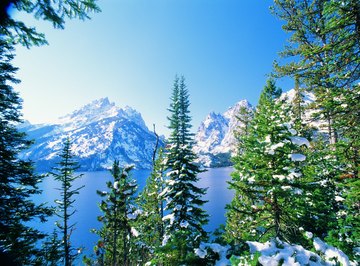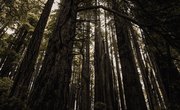
What is the coniferous forest, and which plants are found in the coniferous forest biome? The coniferous forest is also known as the boreal forest, and in North America this type of ecosystem is referred to as the taiga. Made up mostly of cone-bearing trees known as conifers, coniferous forests are found in mountainous regions in Canada, Alaska, Russia and northern Europe. The plants in coniferous forests have several adaptations that help them survive in areas that often experience long, cold winters and short, cool summers.
Trees of the Coniferous Forest
Most of the trees of the coniferous forest are evergreens, which means that they do not shed their leaves during the winter. Evergreens often have small, waxy needle-shaped leaves. These adaptations allow the trees to photosynthesize all year long, and having small needles covered by a cuticle – a protective layer – helps the trees to preserve moisture in the often dry forest conditions.
Some of the conifers that grow in these regions are types of spruces, pines, firs, junipers, cedars and cypress. In the Western conifer forests, tree species include Sitka spruce, western hemlock, western red cedar, Douglas fir, ponderosa pine, lodgepole pine and Colorado blue spruce. Larch, sugar pine, white pine and red fir are some of the trees that grow in the northwestern coniferous forest.
Many coniferous forest locations are at high elevations, typically in areas with mountains. These biomes are often less diverse than other forest types, as their soils lack the nutrients to support species richness. Most of the coniferous trees in these regions are long-lived and slow-growing.
Other Coniferous Forest Plants
Unlike forests with more biodiversity, coniferous forest regions have only two layers: the canopy layer and the undergrowth layer. The canopy layer is composed of the coniferous trees, and the undergrowth layer is made up of the few plants that can survive in the nutrient-poor and shady area near the ground.
Some types of grasses, ferns, mosses and other herbaceous plants and deciduous trees and shrubs grow in the low layer of the forest, but plant life mainly consists of cone-bearing trees. Many of the coniferous trees in these areas are adapted to establish themselves after fires; in fact, some conifers require fire to grow, waiting for occasional fires to release the seeds from their cones.
Conifers tend to have shallow roots and their needles contain tannins, which are chemicals that deter predators from eating them. With needles that spiral around branches, evergreens are ready to capture all of the sunlight available during the short growing season.
Importance of the Coniferous Forest
Like all woodland, the coniferous forest helps sustain all life on Earth. By providing food and shelter for many animal species, the coniferous forest plays an important role on the planet. Home to thousands of species of insects, mammals, birds and fish, these biomes provide critical habitat for many endangered and threatened species.
Coniferous forests provide resources like lumber, pharmaceuticals and fuel for humans, and also provide locations for recreation. Covering large areas of the planet, the plants of the coniferous forest convert carbon dioxide to oxygen through photosynthesis, providing the oxygen we need to survive. The coniferous forest helps cool the surface of the earth with its canopy of needle-like leaves, and also captures and stores carbon in its stems, trunks and roots.
The coniferous trees of these often harsh landscapes survive where others cannot, filling an important ecological niche. Economically important across the globe, the coniferous forest provides timber for construction, pulp for paper making, and food and medicines too. Preserving these unique biomes is critical for the survival of many species, including humans.
References
About the Author
Meg Schader is a freelance writer and copyeditor. She holds a Bachelor of Science in agriculture from Cornell University and a Master of Professional Studies in environmental studies from SUNY College of Environmental Science and Forestry. Along with freelancing, she also runs a small farm with her family in Central New York.
Photo Credits
Jupiterimages/liquidlibrary/Getty Images
